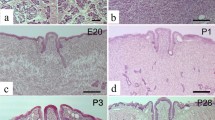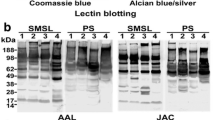Summary
We investigated the localization of blood-group antigens A, B, and H in human labial salivary and submandibular glands by applying a postembedding immunogold method using monoclonal antibodies in combination with the streptavidin-biotin bridge technique. The H, A, and B antigens were only detected in mature secretory granules (SGs), which were mainly found in cells in the late phase of the maturation cycle. In immature SGs, which were present in cells in the early or middle phases of the maturation cycle, these antigens were not detected. All other cytoplasmic organelles were not labeled by the monoclonal antibodies used. In blood-group-O secretors, H antigen was present in almost all of the mature SGs. In blood-group-A secretors, the labelling for H antigen exhibited a mosaic-like pattern, i.e. only some of the mature SGs contained H antigen. With respect to the A and B antigens, a similar mosaic-like pattern of staining was observed in blood-group-A and-B secretors, respectively. To the best of our knowledge, this is the first time that the distribution of blood-group antigens A, B, and H in human tissues has been demonstrated at the electron-microscope-level using monoclonal antibodies.
Similar content being viewed by others
References
Bonnard C, Papermaster DS, Kraehenbuhl JP (1984) The streptavidin-biotin bridge technique: Application in light and electron microscope immunocytochemistry. In: Polak JM, Varndell IM (eds) Immunolabelling for electron microscopy. Elsevier, New York, pp 95–111
Dabelsteen F, Vedtofte P, Hakomori S, Young WW (1982) Carbohydrate chains specific for blood group antigens in differentiation of human epithelium. J Invest Dermatol 79:3–7
Davidsohn I (1972) Early immunologic diagnosis and prognosis of carcinoma. Am J Clin Pathol 57:715–730
Glynn LE, Holborow EJ (1959) Distribution of blood-group substances in human tissues. Br Med Bull 15:150–153
Juhl BR (1985) Methodologic and genetic influence on immunohistochemical demonstration and semiquantitation of blood group antigen A in human ureter urothelium. J Histochem Cytochem 33:21–26
Nakajima M, Ito N, Nishi K, Okamura Y, Hirota T (1987) Cytochemical localization of blood-group substances in human salivary glands using lectin-gold complexes. J Histochem Cytochem (in press)
Pinkstaff CA (1980) The cytology of salivary glands. In: Bourne GH, Danieli JF (eds) International review of cytology, vol 63. Academic Press, New York, pp 141–261
Slot JW, Greuze HL (1985) A new method of preparing gold probes for multiple-labeling cytochemistry. Eur J Cell Biol 38:87–93
Szulman AE (1960) The histological distribution of blood group substances A and B in man. J Exp Med 111:785–800
Szulmann AE (1962) The histological distribution of the blood group substances in man as disclosed by immunofluorescence. II The H antigen and its relation to A and B antigens. J Exp Med 115:977–996
Tandler B, Denning CR, Mandel ID, Kutscher AH (1969) Ultrastructure of human labial salivary glands. I Acinar secretory cells. J Morphol 127:383–407
Author information
Authors and Affiliations
Rights and permissions
About this article
Cite this article
Nakajima, M., Ito, N., Nishi, K. et al. Immunogold labeling of blood-group antigens in human salivary glands using monoclonal antibodies and the streptavidin-biotin technique. Histochemistry 87, 539–543 (1987). https://doi.org/10.1007/BF00492468
Received:
Accepted:
Issue Date:
DOI: https://doi.org/10.1007/BF00492468




